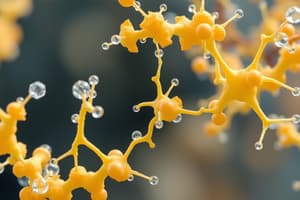Podcast
Questions and Answers
What are glycoproteins primarily composed of?
What are glycoproteins primarily composed of?
- Complex carbohydrates and nucleic acids
- A glycosylated lipid and a protein
- A protein with one or more oligosaccharides linked (correct)
- Single sugar molecules linked together
What is the primary role of lectins?
What is the primary role of lectins?
- To recognize sugar sequences on cell surfaces (correct)
- To form structural components of the cell membrane
- To transport hormones across membranes
- To degrade oligosaccharides in the extracellular matrix
Which of the following best describes proteoglycans?
Which of the following best describes proteoglycans?
- Composed solely of glycoproteins without any external linkages
- Proteins with short fatty acid chains attached
- Only found in the cytoplasm of cells
- Macromolecules that include GAG chains linked to membrane proteins (correct)
What role do glycolipids play in biological systems?
What role do glycolipids play in biological systems?
How does cholera toxin affect human cells?
How does cholera toxin affect human cells?
Flashcards are hidden until you start studying
Study Notes
Glyconjugates
- Sugars are linked to proteins or lipids forming glycoconjugates.
- Proteoglycans: Large molecules found on cell surfaces or within the extracellular matrix. They consist of a protein core with long chains of glycosaminoglycans (GAGs) attached.
- Glycoproteins: Proteins with one or more oligosaccharide chains linked to them.
- Glycolipids: Lipids with oligosaccharide chains attached to their polar head group.
Proteins
- Proteoglycans: A major component of the extracellular matrix, they form aggregates with hyaluronic acid.
- Integrins: Proteins that link the extracellular matrix and cytoskeleton, enabling communication between the cell exterior and interior.
- Collagen, Fibronectin, Elastin, and Proteoglycans: These components work together to create the extracellular matrix, providing structural support and organization to tissues.
- Actin Filaments: Form the cytoskeleton, providing structure and shape to cells. These filaments also connect to integrins, further linking the extracellular matrix and the cell interior.
Glycoproteins
- Glycoproteins: Found on the exterior of cell membranes, they play various roles.
- Glycoforin A: A glycoprotein found in red blood cell membranes.
- Hormones (FSH, LH): Examples of glycoproteins that function as hormones.
- Immunoglobulins: Antibodies that are also glycoproteins.
Glycolipids
- Glycolipids: Membrane lipids with oligosaccharide chains as a key component of their polar head groups, interacting with proteins on the membrane's exterior.
- Gangliosides: A specific type of glycolipid with a complex carbohydrate structure, important for cell recognition and signaling.
- Blood Groups: Glycolipids play a crucial role in determining blood types.
Lectins
- Lectins: Proteins that bind specifically to sugar sequences, found on cell membranes.
- Influenza Virus: Recognizes host cell sugars using lectins to gain entry.
- Herpes Virus: Also uses lectins for binding and infection.
- P-selectins: Lectins that slow down lymphocytes, allowing the immune system to target inflamed blood vessels.
Toxin
- Cholera toxin: Recognizes oligosaccharides of gangliosides on enterocytes, leading to the severe symptoms of cholera.
Studying That Suits You
Use AI to generate personalized quizzes and flashcards to suit your learning preferences.



